Edie Melson's Blog, page 166
April 18, 2021
Take Your Book Launch Team to the Next Level with Pizzazz & Power

by Karen Whiting @KarenHWhiting
Launch teams also called street teams or scream teams encourage members to spread the word about the new book everywhere. Start asking people to sign up several months before the release and include people who already love your writing. Checkout https://thewriteconversation.blogspot.com/2016/04/street-teams-for-book-launches.html to learn about starting a team. Let’s add pizzazz to make it fun and power teams up with effective strategy.
Plan Ahead
Start with listing your goals and incentives. Then share with your team your vision of support and hopes of the launch as well your task plans. Include expected post, frequency, expectations of sharing posts, reviews, and more. Let them know of planned FB lives, online meetings, or any personal benefits such as consulting if the book is for an audience who might benefit from a session.
Incentives inspire participation. Some people use a point system to gain a special incentive. It’s a call to action. It might be 5 points for each social media likes, 2 points for comments posted each week, 30 points if you ordered a copy of the book, etc. Be clear on how you want to know if someone ordered a copy.
Add in ideas to make it the book launch fun, such as games, guests who had a part in the book (contributed a story, made meals while you wrote, etc.), or anecdotes of what happened on the publication journey. People like inside information just for them.
Janet McHenry brought in guests to a live launch event for graduates when she had a book for graduates released. Each shared their story from the book. This can be done with prerecorded clips or on a zoom call with your team.
Games with a Purpose
Many team members like games, especially if you do an online party. Choose games that tie to your book or develop more promotional material.
Word scramble or word search with related to facts about the book such as the setting or problems addressed, or topics covered. This helps team members get familiar with the contents of the book. One done after they’ve read the book could use character names or solutions offered in the book.Trivia facts about you the author they may not know. This can add to what they will share as they spread the word about the book, especially if it includes some humor or fascinating facts.Mad libs of one paragraph or page from your book can be hilarious and an opportuity to share what really happened in that section.Meme caption contests can build posts for you. I put out photos for team members to write captions. We voted on the best caption with a prize to the person who wrote it. One was a mama bear with a baby bear racked out on her back to go with my book for moms. This gave me more captions to use on photos I like. Find it fast. Pick a page number from your book and see who can find the full phrase/sentence of a word you read from the page.To think of more games, join a few launch teams or participate in an online launch party. Carl McAdoo holds a new party for multi-authors who have releases that month and they post lots of games.
Make the Most of Incentives
Sending gifts as free downloads of physical ones shows you care. My friend Sue Kuenzi was touched when she took in a book launch. The authors sent every member a journal with a copy of the book and asked members to share their own stories. That brought more engagement. The right prizes make a big difference.
Match the incentives to your book or brand. For my Growing a Mother’s Heart new release, I had some cute mom plaques that reflected colors of the book and also used gardening gloves and tools as a reminder of the word growing. With a craft book coming up the end of the year that I am co-authoring with my daughter Rebecca White, we are creating some craft kits as incentives.
Consider the reasons for incentives. Yes, some are simply to keep up enthusiasm. Others may be to get people involved or a call to action. I gave you a free pdf book to anyone who invited someone to join the group (even if they did not join). The new members increased the group size by 33% ad added excitement as we welcomed new members.
Set incentive rules. Will someone be able to win every week? Or will they not win again but have their name put in to the drawing for the grand prize? Or is there a reset on winning mid-way through the launch? Does every task does completed count, or just weekly goals met add an extra ticket to the grand prize drawing? Be clear when you post a list of incentives how people win.
Gain From Team Members
Ask members for quotes that impacted them, favorite stories, and sections. That helps you choose what to post and blog about. Ask what images come to mind and use those as fodder for creating memes.
Read reviews posted to use some as quotes to post. Share the reviews. The reviews can give you more insight into your reader and the great selling points of the book.
TWEETABLE
 Make your next launch a great success and share what works with other writers!Karen Whiting (WWW.KARENWHITING.COM) is an international speaker, former television host of Puppets on Parade, certified writing and marketing coach, and award-winning author of twenty-seven books for women, children, and families. Her newest book, The Gift of Bread: Recipes for the Heart and the Table reflects her passion for bread and growing up helping at her grandparent’s restaurant. Check out her newest book Growing a Mother’s Heart: Devotions of Faith, Hope, and Love from Mothers Past, Present, and Future. It's full of heartwarming and teary eyed stories of moms.
Make your next launch a great success and share what works with other writers!Karen Whiting (WWW.KARENWHITING.COM) is an international speaker, former television host of Puppets on Parade, certified writing and marketing coach, and award-winning author of twenty-seven books for women, children, and families. Her newest book, The Gift of Bread: Recipes for the Heart and the Table reflects her passion for bread and growing up helping at her grandparent’s restaurant. Check out her newest book Growing a Mother’s Heart: Devotions of Faith, Hope, and Love from Mothers Past, Present, and Future. It's full of heartwarming and teary eyed stories of moms.Karen has a heart to grow tomorrow’s wholesome families today. She has written more than eight hundred articles for more than sixty publications and loves to let creativity splash over the pages of what she writes. She writes for Crosswalk. Connect with Karen on Twitter @KarenHWhiting Pinterest KarenWhiting FB KarenHWhiting
April 17, 2021
Invite God into Your Writing

by Tammy Karasek @TickledPinkTam
At one of my writing meetings in March, a friend shared with the group some interesting facts she’d come across in a recently read book. Often our devotions or book reports shared in our meetings stick with me for a few days as I keep going over them in my mind. But this time, something that was shared has impacted me greatly. It’s still on my mind more than a month later. The friend has no idea.
As Christian writers we pray before we start a new project asking God to give us the words he’d have us share. Again we pray as we sit down to actually do the writing of said project. We know we’ve been called to write and want to walk in that obedience. Our intentions are to write what we feel God leading us to do.
And then we get to the business of writing on our terms, our schedule and eventually our thoughts and words.
We may hurry into our writing without our pause for prayer first. We can inadvertently in our haste to complete the project do it our own way. I believe someone named Frank sang about doing it my way. I can’t answer for you, but I can honestly say that is me more than I like to admit. Doing it my way.
However, since the meeting in March, I’ve approached my writing in a much different way. Anyone heard of conviction? Try as I might, I am guilty for not inviting God into my writing time. (And I wonder why I have writer’s block at times.) Now, I have two sets of letters on my screen in lime green post-its. One on the top left and one on the top right. The one on the left is TLK/JJ. The one on the right is TLK/SDG.
Initials to remind me whose help I need and who receives all the credit.
You’ve probably heard of someone with the initials JSB. I’m speaking of Johann Sebastian Bach. What I never knew about Mr. Bach was he had a strong faith. So much so, no matter whom he was writing his music for he would start composing by petitioning Christ to help him with it.
Once done, he would give the credit to God.
At the beginning of his musical compositions, it has been said that Mr. Bach would sometimes write the letters JJ for Jesu juva—Latin for Jesus, help. Then he would begin.
Once done, he would add the initials SDG, Soli Deo Gloria, at the end which he meant that all of his work was done for the glory of God alone.
It was these simplistic prayers of Johann Sebastian Bach that impacted me to create the habit of saying out loud Jesus help as I reach over to turn on my computer to work. Then to bookend my work time to be ended with Soli Deo Gloria, for the glory of you alone, God.
I pray this will encourage you to invite God into your writing and cover your time with the help of Jesus. Then once your session is done you remember who gets the glory.
Soli Deo Gloria
TWEETABLEInvite God into Your #Writing - @TammyKarasek on @EdieMelson (Click to Tweet)
 You’ll find Tammy using humor and wit to bring joy and hope to every aspect in life. She’s gone from down and defeated from a past filled with bullying and criticism from family to living a Tickled Pink life as she believes there is always a giggle wanting to come out! All because of HIM.
You’ll find Tammy using humor and wit to bring joy and hope to every aspect in life. She’s gone from down and defeated from a past filled with bullying and criticism from family to living a Tickled Pink life as she believes there is always a giggle wanting to come out! All because of HIM.She’s the Social Media Coordinator for the Blue Ridge Mountains Christian Writers Conference. President of ACFW Upstate SC, Past-President and current member of Word Weavers Upstate SC and Past-President of Cross N Pens Writers Group. She’s a member of My Book Therapy/Novel Academy. A writing team member for The Write Conversation, contributor for the Learn How to Write a Novel Blog and others. Published in the Divine Moments Compilation Book—Cool-inary Moments.
She’s married to her college sweetheart Larry, a mom to their grown daughter, Kristen and excited to add a son-in-law in 2021. Born and raised in Ohio, she now lives in South Carolina. Connect with Tammy at HTTPS://TAMMYKARASEK.COM.
April 16, 2021
Reflection, Fellowship, Inspiration—Writer's Tools

by Emme Gannon @GannonEmme
The tall iron gates lay open like welcoming arms. We entered and trudged slowly along the wide pathway, the only sound the crunch of gravel beneath our feet. As we rounded the bend, the sprawling eighteenth century stone villa came into view and looked to be perched on a cloud of gentle sloping hills.
As if preparing for our visit, the sky sent gentle drops of rain, baptizing the landscape with a brilliant sheen. I paused, mesmerized by the beauty and anticipation of what blessings lay before us. And the rain mingled with my tears.
One doesn’t just visit Tuscany. The land is too alive with stimulation, scents, sounds, and visions that woo all who are brave enough to savor each moment and deliciously ingest its wonder. While it is the birthplace of Renaissance and home to world famous art masterpieces, including Michelangelo’s David, it is the countryside with its rolling green hills and olive grooves that catered to my soul.
Our bedroom, with its high ornate ceilings opened to a library where logs had been placed in the fireplace just in case we wished to read by the warmth of a fire. We opened the ornate wooden door opposite the fireplace and discovered a rooftop deck where we arrived just in time to watch the long shadows of sunset slide across the hilly terrain causing the land to look as if it had just been dipped in a rainbow. The only sound was the breeze as it caressed the nearby trees. We’d not known such silence—the kind that causes one to imagine the sound of the grapes growing in the vineyard below.
At night we’d fling open the casement window, fall asleep under the thick-curtained canopy bed, and wake to the sound of birdsongs and a lone rooster announcing the new day. Absent was the swish of cars and trucks whizzing by. Only the reverential quiet of the land as it readied for a new day. Stepping onto the roof top deck, we could hear distant church bells carried by the breeze from a far off village.
Unburdened by the sounds of urban life, my mind was free to rest and release hidden dreams and aspirations, to breath quietly with the gentle rhythm of the peaceful countryside. Joy caught us by surprise. As I grabbed my journal, my pen could not keep up with descriptions of my sense of wonder.
Days were spent exploring nearby medieval towns with other guests of the villa, where we’d walk on centuries old cobblestone paths. Then the small city of Florence with its cathedrals and artistic treasures. By late afternoon, we’d be back to the villa where we’d gather for a magnificent meal prepared from local delicacies like fresh picked vine-ripened tomatoes that would explode in our mouths and stimulate our taste buds with sweet sour savory lusciousness.
After sharing our experiences with our fellow travelers, we’d return to our room, inspired by the restorative power of reflection, fellowship, and the inspiration that had been birthed.
Psychiatrists have long extoled the restorative power of gardens and nature on mental health. While my Tuscan memories are from long ago, they are alive because they were intensified by taking time to let its beauty feed all the senses and sharing experiences with others.
These days, my soul is nurtured by my own garden and connecting the beauty of nature with past experiences, letting my mind draw up memories like the sun pulls water into the sky and forms clouds which then send the moisture back again to the earth to refresh and bring life to the land. I think that’s what sweet memories do. They attach themselves to us and bring new life. And words. And stories.
TWEETABLEReflection, Fellowship, Inspiration — Writer's Tools - @GannonEmme on @EdieMelson - http://ow.ly/qxzP50EqWfL #writing #Writerslife (Copy highlighted text and paste in Twitter to Tweet, Click to Tweet isn't working)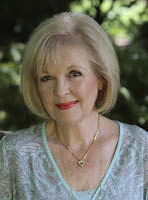 Emme Gannon is a wife, mother, and grandmother who loves to write stories that stir the heart. Her award-winning writing has appeared in Focus on the Family magazine, several anthologies, and numerous newsletters. She just completed her first novel.
Emme Gannon is a wife, mother, and grandmother who loves to write stories that stir the heart. Her award-winning writing has appeared in Focus on the Family magazine, several anthologies, and numerous newsletters. She just completed her first novel.
April 15, 2021
Writers Are Seed Planters

by Crystal Bowman
I’ve been involved in volunteer ministries ever since I was a high school graduate. Summer mission programs, Sunday school teacher, Bible study leader, vacation Bible school teacher— and for more than 20 years I’ve been a mentor for MOPS (Mothers of Preschoolers).
But through these 40+ years of being in ministry and sharing the Gospel, I rarely saw anyone come to know Jesus. However, I am overwhelmed by the number of times someone who was exposed to my teaching came to me with exciting news that they had received Jesus as their Savior. They would tell me that something I said, something I taught, that walk on the beach, that Bible study in my living room, or those weekly two-hour phone calls started them on their journey to find Jesus. And I would be happy for them, but often wondered why I wasn’t the one to be with them during their come-to-Jesus moment.
Then I read these words in 1 Corinthians 3:5-8 (NLT):[The Apostle Paul, writing to the church in Corinth ] “After all, who is Apollos? Who is Paul? We are only God’s servants through whom you believed the Good News. Each of us did the work the Lord gave us. I planted the seed in your hearts, and Apollos watered it, but it was God who made it grow. It’s not important who does the planting, or who does the watering. What’s important is that God makes the seed grow. The one who plants and the one who waters work together with the same purpose. And both will be rewarded for their own hard work.”
My moment of truth: I am a seed planter!
Even though I may not be the one to pray with someone to receive Christ, my seed planting is an important and necessary part of the process.
And as writers—we are all seed planters!
Our books, blogs, magazine articles, and chapter contributions are distributed to thousands if not millions of people both nationally and globally. When we share biblical truths in our writing, when we encourage others in their faith, and when we present the Gospel message, we are planting seeds that others may water. Or maybe we are watering seeds that others have planted. We may never be face to face with most of our readers. We may never find out who came to faith in Jesus because of something we wrote. But our words matter and the seeds we plant will add believers to God’s Kingdom.
Keep planting those seeds.
Whether you write for children, teens, or adults, there is always room for more seed planting. I write mostly for children which means I can plant those seeds while they are young. If you write for teens or adults, your words might plant seeds, or they might water existing seeds. And it’s God who makes those seeds grow into seeds of faith.
Knowing that my words are planting seeds, gives my writing a greater purpose. Impressive book sales are encouraging. Awards are exciting. And some of us even get royalty checks now and then! But all of that pales in comparison to the heavenly reward that comes from advancing the Kingdom of God with the words we write and the seeds we plant.
So writers—keep planting and watering seeds for the Master Gardner and watch His garden grow.
TWEETABLEWriters are Seed Planters - Crystal Bowman on @EdieMelson (Click to Tweet)
 Crystal Bowman is an award-winning, bestselling author of more than 100 books for children and four nonfiction books for women. She also writes lyrics for children’s piano music and is a monthly contributor to Clubhouse Jr. Magazine. She loves going to schools to teach kids about poetry. She also speaks at MOPS (Mothers of Preschoolers) groups and teaches workshops at writers’ conferences. When she is not writing or speaking, she enjoys going for walks, working out at the gym, and eating ice cream. She and her husband live in Michigan and have seven huggable grandkids.
Crystal Bowman is an award-winning, bestselling author of more than 100 books for children and four nonfiction books for women. She also writes lyrics for children’s piano music and is a monthly contributor to Clubhouse Jr. Magazine. She loves going to schools to teach kids about poetry. She also speaks at MOPS (Mothers of Preschoolers) groups and teaches workshops at writers’ conferences. When she is not writing or speaking, she enjoys going for walks, working out at the gym, and eating ice cream. She and her husband live in Michigan and have seven huggable grandkids. WWW.CRYSTALBOWMAN.COMWWW.FACEBOOK.COM/CRYSTAL.BOWMANWWW.FACEBOOK.COM/CRYSTALJBOWMANWWW.INSTAGRAM.COM/CRYSTALBOWMANAUTHOR
April 14, 2021
The Differences Between Self-Publishing and Traditional Publishing
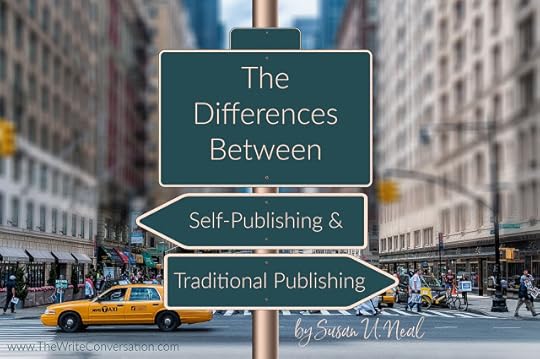
by Susan U. Neal @SusanNealYogaShould you traditionally publish or self-publish? Some authors can’t land a traditional publishing contract, so that is not an alternative. Since the pandemic, it has become even more challenging to get a traditional contract. Other authors are traditionally published and could continue to do so but are curious about self-publishing. They may get frustrated about specific aspects of the traditional world.
Initially, self-publishing was seen as inferior work. Now, very successful traditionally published authors have turned to self-publishing, so they do not have to share their profits. In addition, they are in charge of the publishing schedule and can publish a book much quicker. However, they have to coordinate all the aspects of creating a professional-looking book. This article will look at the advantages and disadvantages of self-publishing and the technical aspects of it.
Advantages
The author:
Receives all the profitsControls the publishing timelineCan edit their manuscript if an error is found after publicationCan edit a book cover or add an award emblem after publicationCan expand their book’s Amazon categoriesCan put their books on sale for a special promotionDisadvantages
The author:
Does not have the resources and guidance of a traditional publisher Has to hire an editor, proofreader, cover designer, and book formatter or do it themselfMust learn the publishing steps Need funds to purchase the ISBN, publish on IngramSpark, and pay for other servicesSome things remain the same with self-publishing or traditional publishing. The author needs to write a well-written, compelling book and is responsible for marketing it. With a traditional publisher you do incur the cost associated with publishing a book. However, after the book is published, you do not have control of it (editing an error, putting it on sale, expanding Amazon categories, etc.). Traditional publishing has its perks, as you do not have to worry about all of the nitty-gritty phases of preparing your book for publication. Your input is requested at pertinent points within the publishing process, but otherwise, you can sit back and relax. As a traditionally published author, you do have to share your profits, though.
If you are a seasoned author who understands the publishing process and has the financial resources to publish a book, it might be prudent to try self-publishing. If you don’t like it, go back to traditional publishing. I know successful authors who are hybrid published. They have numerous books published by traditional publishers. But when a traditional publisher rejects a manuscript, they self-publish it.
Now let’s look at the intricacies of self-publishing so if you choose this route, you know what you’re getting yourself into.
ISBN
A self-published author needs to purchase their ISBN for each of their books. It is placed on the back cover and the copyright page.
Cover
You need to find an excellent cover designer and create a great title and subtitle. There are specific things required on a book cover, including the retail price and Book Industry Standards & Communications (BISAC) code. A book cover should be visually pleasing yet stand out at the same time. You should check your book’s thumbnail version to ensure that you can see the image and read the title. The title and subtitle should portray the topic of your book and include keywords.
Keywords, Amazon Categories, & BISAC Codes
A self-published author should learn the strategies for determining the most searched keywords on Amazon and Google. Those keywords should be applied to their book’s title and description, so readers easily find it. Amazon allows you to place your book in ten categories. Most publishers only include your book in three. A traditionally published author has no control of this. A self-published author can expand their book’s categories which could result in the book ranking higher in a specific category on Amazon. For example, when I added the category healthy diet to 7 Steps to Get Off Sugar and Carbohydrates, it went from #98 in the diet category to #1 in the healthy diet category. If you want to learn how to expand your book’s categories, take the course Improve Your Book’s Amazon Rank By Expanding Categories & Strengthening Keywords.
A self-published author would also need to understand BISAC codes which provide industry-approved alphanumeric codes assigned to topical book subject headings. Basically, it’s a book category. For example, Young Adult Fiction and Biography & Autobiography are BISAC codes. A BISAC code on the back of your book tells the bookstore which section of the store to put your book in.
Editor and Proofreader
All published books should be edited by a professional editor. As a self-published author I needed to find an editor, so I contacted the chair of a large Christian writers conference and asked who she recommended. She referred me to an excellent nonfiction editor and my book, 7 Steps to Get Off Sugar and Carbohydrates, won the Selah Award. Additionally, I hired several people to proofread my book after it was formatted.
Front and Back Matter
There are industry standards for what is included in the front matter, such as endorsements, title page, copyright page with the ISBN, dedication page, table of contents, and more. The back matter includes the appendix, glossary, notes, index, study guide, discussion questions, author bio, connect with readers, and more. If you want to publish a professional book, take the course How to Create a Professional-Looking Book. You need to understand all the information required for the book cover, formatting of the body, and front and back matter.
Book Format
Now that you have your book edited, cover professionally designed, and understand what is included in the front and back matter, it is time to format your book. There are several options for formatting:
Figure out how to format your book on Word and create a PDF file for your print book and an EPUB file for your e-book. Use KDP.com’s formatting option. Hire a professional formatter. Purchase the Mac product called Vellum, which costs $250, and with a little training, format your own book.I use Vellum. I had about three hours of training and found it easy to use. After you publish two books, you’ve paid for this software program. And you can easily edit your book. Every time I publish a new book, I edit my previous books’ Vellum file and add my latest book to the back matter. That’s a very effective way for your readers to find your new products.
Now that you have completed all of these steps, you can upload your files to two different self-publishing platforms, KDP.com (which is Amazon) and IngramSpark. Both of these platforms are easy to use. You upload the title, subtitle, author, ISBN, categories, keywords, book cover, and book file (PDF or EPUB). Once all the information is loaded, you could publish it, but I recommend ordering several print books first. I distribute those proof copies to my paid proofreaders. As they find errors, I edit the book’s Vellum file and recreate a new ePub and PDF files to upload to KDP.com and IngramSpark. Then I publish the book.
As you can tell there is a lot to learn about independent publishing. If you like to learn and control all the aspects of your book, you will enjoy it. If you choose the self-publishing route, I recommend joining the Christian Indie Publishing Association. This association was founded in 2004 to help self-published authors publish like a professional. Why do it alone when you can join this association which provides educational resources and discounts (free IngramSpark publishing) to make your publishing experience easier and more profitable?
What are your thoughts on this topic? Are you ready to give self-publishing a try? I enjoy coaching authors through the self-publishing process. Feel free to contact me for a free 20-minute consultation at https://susanuneal.com/authorcoaching.
TWEETABLEThe Differences Between Self-Publishing and Traditional Publishing - Susan U. Neal, @SusanNealYoga on @EdieMelson (Click to Tweet) Susan U. Neal, RN, MBA, MHS: Susan’s mission is to improve the health of the body of Christ. She has her RN and MBA degrees, as well as a master’s in health science. She is a CERTIFIED HEALTH AND WELLNESS COACHwith the American Association of Christian Counselors. She published five books, the Selah award winner 7 STEPS TO GET OFF SUGAR AND CARBOHYDRATES, CHRISTIAN STUDY GUIDE FOR 7 STEPS TO GET OFF SUGAR AND CARBOHYDRATES, HEALTHY LIVING JOURNAL, SCRIPTURE YOGAa #1 Amazon best-selling yoga book, and YOGA FOR BEGINNERS which ranked #3. She published two sets of Christian Yoga Card Decks and two Christian Yoga DVDs that are available at CHRISTINAYOGA.COM. Her digital product HOW TO PREVENT, IMPROVE, AND REVERSE ALZHEIMER’S AND DEMENTIA is a great resource. To learn more about Susan visit her website SUSANUNEAL.COMYou can also connect with Susan on FACEBOOK, TWITTER, and INSTAGRAM.
Susan U. Neal, RN, MBA, MHS: Susan’s mission is to improve the health of the body of Christ. She has her RN and MBA degrees, as well as a master’s in health science. She is a CERTIFIED HEALTH AND WELLNESS COACHwith the American Association of Christian Counselors. She published five books, the Selah award winner 7 STEPS TO GET OFF SUGAR AND CARBOHYDRATES, CHRISTIAN STUDY GUIDE FOR 7 STEPS TO GET OFF SUGAR AND CARBOHYDRATES, HEALTHY LIVING JOURNAL, SCRIPTURE YOGAa #1 Amazon best-selling yoga book, and YOGA FOR BEGINNERS which ranked #3. She published two sets of Christian Yoga Card Decks and two Christian Yoga DVDs that are available at CHRISTINAYOGA.COM. Her digital product HOW TO PREVENT, IMPROVE, AND REVERSE ALZHEIMER’S AND DEMENTIA is a great resource. To learn more about Susan visit her website SUSANUNEAL.COMYou can also connect with Susan on FACEBOOK, TWITTER, and INSTAGRAM.
April 13, 2021
Taking the Next Step in your Article Writing
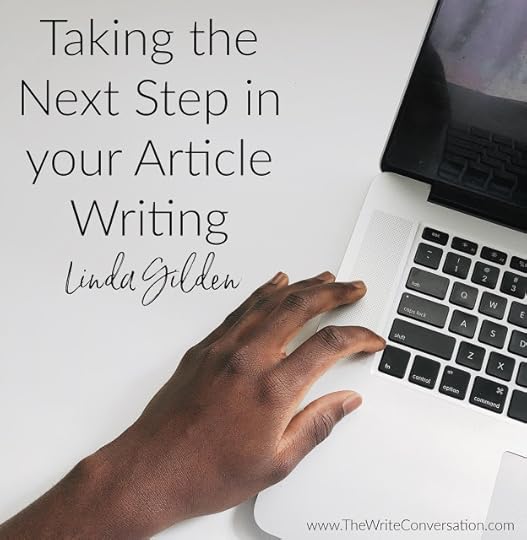
by Linda Gilden @LindaGilden
Every now and then it is a good idea to take stock of where you are sending your articles. Are they hitting the mark? What part of your article writing business do you want to do better?
I recently had a season like that. I was writing four columns a month, many articles, and always looking for new ideas, all while working with my coaching clients and several books. But it seemed that many times I pushed that send button with a sigh. Could I write for a publication with a larger circulation so I can reach more people? Am I content with the amount I am being paid? Does the depth of my research provide a good foundation for my articles?
Two of my columns are on parenting/grandparenting so I decided that would be a good place to start. First thing I had to decide was what were my criteria. What were the things that I was really looking for? What kind of changes was I looking to make?
I googled parenting magazines, paying close attention to whether or not they published articles on grandparenting. Since those are subjects I frequently wrote about, I had a storehouse of information on those subjects. I looked in the market guides, checking word count, lead time, and payment. I read the tips section that spotlighted those things they were particularly looking for. If possible, I went to the website and read some of the back issues checking to see if my style of writing might work for that publication. And, of course, checked the current editor’s name so I could direct my work to the best possible place.
I located a few good prospects and got busy with my queries to those publications.
Likewise, I decided to check out new writing magazine markets. I repeated the same process and this time I paid attention as to whether the publication accepted reprints or not. I searched for publications that were new to me as I wanted to branch out and find new opportunities for my writing.
Perhaps choosing a new types article to write will spur your creativity in a different direction. If you mainly write profile articles, why not try a round up article. Or if you mainly write seasonal articles, try a how-to article. Different magazines prefer different types of articles which will expand your reach as well.
Another great opportunity for new places to submit articles to is to find a brand new, startup magazine. Often new magazines don’t have large groups of writers they depend on so they build their group as the magazine gets going. If you find a startup publication, be sure to turn your articles in on time and always follow the guidelines. If you have an assignment, make sure you do exactly what the editor asks for and deliver what your query promises. You’d be surprised how often people forget to check those things. Then as soon as you send your article in to the editor, email him or her with a few other topics you would like to write for them. In other words, keep that ball rolling! Eventually, you will find the editor may contact you when an article he or she would like to see comes to mind and fits your style.
For me, it is a good idea to assess where you are in your article writing at least once a year. Write down your goals and determine what your best steps to meeting your goals are. Give us one of your goals in the comments. That will give you accountability. Then, next year, give us a report if you have reached that goal or if you are still working on it. As long as you are doing something that moves you closer to your goal, you are still making progress.
Looking forward to watching you take the next step in your writing journey!
TWEETABLETaking the Next Step in Your Article Writing - @LindaGilden on @EdieMelson (Click to Tweet)
 Linda Gilden is an award-winning writer, speaker, editor, certified writing and speaking coach, and personality consultant. Her passion is helping others discover the joy of communicating with excellence. In the midst of all the busyness, Linda’s favorite activity is floating in a pool with a good book surrounded by splashing grandchildren—a great source of writing material! www.lindagilden.com
Linda Gilden is an award-winning writer, speaker, editor, certified writing and speaking coach, and personality consultant. Her passion is helping others discover the joy of communicating with excellence. In the midst of all the busyness, Linda’s favorite activity is floating in a pool with a good book surrounded by splashing grandchildren—a great source of writing material! www.lindagilden.com
April 12, 2021
Develop Your Book's Hook With These Three Questions

by Cindy K Sproles @CindyDevoted
Writers hear valued advice daily. Conflict drives the story. Character development is critical. The plot must push readers through to the end, only to mention a few. There is one aspect of our writing that jumps ahead of conflict, characters, and plot. It’s the first thing the reader sees. The line that makes them decide on the spot, whether they will continue to read. The hook—and oh, baby—is this ever important.
LET’S LOOK DEEPER AT THE HOOK
Seasoned writers understand the value of a good hook. Many are like myself pouring days over that first page until it’s perfect. To begin, here are a couple of questions you need to ask yourself about the beginning of your book. Keep in mind, there are exceptions to every rule but truthfully, on the hook, it’s hard-pressed to skimp.
Question one: Is my hook on the first page of my draft? Well, is it? The hard truth is, readers are very finicky creatures. They know what they like to read and the amount of time they give you to “clue” them in on the conflict, is short. Some readers will allow the writer five pages before they throw caution to the wind and your book out of the window. Approximately 30% will give you to the end of the first page, another 70% insist you give them a solid “draw them in moment” in the first three paragraphs. That’s a little frightening when you think about it. It makes our readers seem somewhat fickle but cut them some slack. Most are avid readers who consume book after book like M&M’s in a bowl. This should tell you something. A) Readers are smart B) Readers want to be pulled into the story immediately. This is a great gaging tool for you as you begin your novel.
I see loads of manuscripts beautifully crafted but what they lack is the “draw me in moment.” They’re filled with amazing descriptions and they paint beautiful pictures in my head, but what is a beautiful picture without the reason? As an editor, I find newer writers will locate their hook about seven to ten paragraphs into the first chapter. Remember, that 70%?
Question two: What is the conflict my protagonist is experiencing and how can I drop my reader square into the middle of that conflict? How can I gut-punch them with words and when they catch their breath, start them running alongside the protagonist? You know your story so search it out.
It’s important to remember that a good hook does not always represent an action-packed scene. Many times it’s a quandary, a situation, a problem the protagonist battles with. For example, Charlotte Bronte’s hook from Jane Eyre.
“There was no possibility of taking a walk that day.”
Or Herman Melville’s Moby Dick.
Call me Ishmael.
A hook doesn’t have to be a killing spree or a mad race. It simply needs to force the reader to ask this all-important question – “What on earth is going on here?”
A good hook can be contemplative like in Charles Dickens’ A Tale of Two Cities – It was the best of times, it was the worst of times, it was the age of wisdom, it was the age of foolishness, it was the epoch of belief, it was the epoch of incredulity, it was the season of Light, it was the season of Darkness, it was the spring of hope, it was the winter of despair. (Comtemplative but curious.)
Your hook can very well be dropping the reader into the middle of a battle, with guns or swords wielding. Whatever you choose, it absolutely must make the reader ask “What on earth is going on here?” When the reader asks that question, their curiosity forces them to turn the page and if you work hard to craft your paragraphs, you will drag them by the nose ring from chapter to chapter.
Question three: Does my hook set the pace for the story? – I’m sure you’ve heard writing instructors talk about pacing. What is pacing? Pacing is the speed that your story is told. It doesn’t necessarily mean the speed at which the story takes place rather it’s the length of scenes and pages, how quickly the action moves and moving the story ahead at a pace that doesn’t bog the reader down. It’s how quickly the writer feeds the reader information. Look over your first couple of pages and once you nail down your hook, then put it through the tests. Does it feed your reader quickly or does it weigh them down with unnecessary information otherwise called backstory? We sometimes feel as though we need to give the reader every detail but it’s not necessary.
Remember, our readers are smart. Think of a movie. When the first scene opens you are thrust into the middle of a moment. Nothing works you up to it by telling you all the information that led to that moment (again, there are exceptions to every rule but rules have to be broken properly or the result is still a lost reader.) We want our readers to jump into the fiction bubble and live out loud not have them questioning why we didn’t just get to the point. Anything that forces your reader to rabbit trail, ends with a frustrated reader.
KNOW THE PURPOSE OF YOUR STORY
One final tidbit. Know the purpose of your story. Know what you want the reader to take home at the end of the day. We end our days, months, and sometimes years, there are life lessons. Some end perfectly while others cause us to stumble to our feet, dust off our knees, and repeat that we will not tread that path again. Your story is the same way. If you haven’t explored your plot enough or dug into your characters deep enough before you start to know what you want the reader to take away from the story, then you will have readers who close the book unfulfilled. When you craft your hook, it’s important to know the purpose of the story so that the beginning defines the goal or desire of the protagonist and sets them on a journey to fulfill that desire.
Hooks aren’t always taken seriously. We are so excited to get into the meat of the story that we leave the reader stuck on the bench waiting for the train. Discover the hook of your story and craft it with great precision. If you need inspiration, search for the best hooks in literature and I would bet you will recognize the greats all have block-buster hooks.
Your challenge is to stop where you are in your work and search out your hook. If you can get it into the first line or paragraph, then awesome but don’t let it slip onto page two.
Feed your reader and they will thirst for more.
TWEETABLEDevelop Your Book's Hook With These Three Questions - @CindyDevoted on @EdieMelson (Click to Tweet)
 Cindy K. Sproles is an author, speaker, and conference teacher. She is the cofounder of Christian Devotions Ministries and the executive editor for christiandevotions.us and inspireafire.com. Cindy is the lead managing editor for SonRise Devotionals and also Straight Street Books, both imprints of LPC/Iron Stream Media Publications. She is a mentor with Write Right and the director of the Asheville Chrisitan Writers Conference held each February at the Billy Graham Training Center, the Cove, Asheville, NC. Cindy is a best selling, award winning novelist. Visit Cindy at www.cindysproles.com.
Cindy K. Sproles is an author, speaker, and conference teacher. She is the cofounder of Christian Devotions Ministries and the executive editor for christiandevotions.us and inspireafire.com. Cindy is the lead managing editor for SonRise Devotionals and also Straight Street Books, both imprints of LPC/Iron Stream Media Publications. She is a mentor with Write Right and the director of the Asheville Chrisitan Writers Conference held each February at the Billy Graham Training Center, the Cove, Asheville, NC. Cindy is a best selling, award winning novelist. Visit Cindy at www.cindysproles.com.
April 11, 2021
Speaking Tips for Authors & Using Props Online
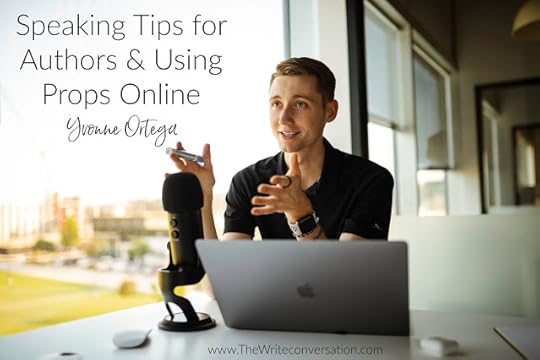
by Yvonne Ortega @YvonneOrtega1
How can you use props in professional presentations online?
First, number and place your props in order.
If you number your props, then you can place them in the order that you need them. If you don’t have them in order, panic may set in when you search for the one you need. I watched a virtual event in which the speaker couldn’t find his next prop. His smile became a frown, and beads of perspiration formed on his forehead. I felt sorry for him. I wondered if his blood pressure had sky-rocketed when the armpits of his shirt looked like he needed to use a suction pump on them.
At my first TV interview, I had my props in the order I needed them. However, I should have made sure they were all unwrapped. The seconds it took to unwrap the mask I used as a prop seemed like hours.
Second, keep your audience engaged with props.
You can engage your audience even if you’ve never met them before. Inform the event planner ahead of time to ensure attendees have their name on the screen. Call on them by name when you ask questions. Include polls where you use ScreenShare and have them answer on the spot. One of your props for engagement is music at the break for ten or fifteen minutes every hour and a half. Your attendees cannot sit for three hours or all-day long. They may lose interest, get sleepy, read their email, or text. They need to stretch, use the restroom, get a drink of water, a cup of coffee or tea. Some may look for their favorite milk chocolate or dark chocolate snack.
Include fun music during the break, and let them dance the Hokey Pokey, the Chicken Dance, or the Charleston. The introverts may turn off their video. That’s okay. The extroverts may leave theirs on and enjoy every second of the music break.
Third, test your background ahead of time.
Test your background ahead of time. What’s behind you can make a big difference to your attendees. It can enhance or distract from your virtual presentation.
A colleague facilitated a group online. Because of the humidity in the room, she pinned her hair up. It looked like the vase behind her sat on her head.
I used a downloadable virtual background for an interview. With the slightest movement, my hair moved on the screen, and my head looked pointed. The host deleted the footage with my flying hair and pointed head, and I no longer use that virtual background. Some speakers say a green screen behind the virtual background helps. Others disagree and add that a green screen is too expensive anyway. Whatever you decide, get online ahead of time to see how you look.
In summary, follow these tips on the use of props in professional presentations online:Number and place your props in orderKeep your audience engaged with themTest your background ahead of timeWhich of these three speaking tips will you focus on this week?
TWEETABLESpeaking Tips for Authors & Using Props Online - @YvonneOrtega1 on @EdieMelson (Click to Tweet)
 Yvonne’s background as a licensed professional counselor brings a unique perspective into the heart of women. She’s a speaking and writing coach and the owner of Moving from Broken to Beautiful®, LLC. She belongs to the Advanced Writers and Speakers Association, the Christian Authors Network, the National Speakers Association, and Toastmasters International.
Yvonne’s background as a licensed professional counselor brings a unique perspective into the heart of women. She’s a speaking and writing coach and the owner of Moving from Broken to Beautiful®, LLC. She belongs to the Advanced Writers and Speakers Association, the Christian Authors Network, the National Speakers Association, and Toastmasters International.She celebrates life at the beach, where she walks, builds sand castles, blows bubbles, and dances.
April 10, 2021
Giving an Encouraging Word

by Martin Wiles @LinesFromGod
So encourage each other and build each other up, just as you are already doing. 1 Thessalonians 5:11 NLT
I ignored the call, imagining it just another spam call from someone who wanted to ruin my Saturday morning with their nonsense.
Writers’ conferences present a double-edged sword. I hang on every word from speakers, authors, and editors who are more experienced than I. Experts who share their journeys and help me with mine. I hear their instructions and cautions. Be patient. The publishing world takes time.
Don’t give up when you receive rejection letters. Perhaps the timing is not right, or you are not as prepared as you need to be. Show don’t tell. Get an agent. Submit something for publication…anything. Make your manuscript, devotion, or article as good as you can before submitting it. Pay an expert to look over it if you need to. Remember, you only write for an audience of One. On and on the good advice trails.
But then that devilish angel hops on my shoulder. I hear him, too. You’ll never succeed. Your writing stinks. Don’t expect any compensation for your writing. Who would pay for what you write?
And hearing from those who’ve experienced a measure of success in selling articles or publishing books doesn’t help. The jealousy bug emerges…angrily…and largely. Why couldn’t the same happen to me? I’ve been writing longer than they have. Why did the agent accept them as a client but reject me? Why did the publisher accept their manuscript but toss mine?
Between sessions, I headed for the bathroom. While taking care of restroom business, I heard the call and saw the number appear on my screen. Although the number was local for where I lived, I didn’t recognize it. Knowing spammers can fake a local number just to make me answer, I ignored the call and waited to see if the caller would leave a voice mail.
A minute or so passed before I heard the ding notifying me I had a voicemail. I waited for it to transcribe. Nothing. I pressed the play button to listen. “You don’t know me, but I’m….”
A pastor with a congregation not far from where I live had read some of my devotions in a denominational magazine. Enjoying what he read, he had investigated my bio. Seeing I had a website, he visited.
And the purpose of his call? Just to give me a word of encouragement. Just to tell me he enjoyed reading my devotions and to express his appreciation for what I did.
“I know we all get a lot of spam callers,” he said, “but I wanted you to know this isn’t what this is. I just wanted to give you a word of encouragement.”
Most of my voicemails, I erase. This one, I saved. A day will come when someone will give one of my books a critical review or put a judgmental comment on one of my blog posts, and I’ll need this voicemail. I’ll need to hear a word of encouragement.
Doing what Paul says takes initiative. Our default mode is often criticism. It seems to come more naturally. But God wants us to do what this stranger did. I needed encouragement that day. He didn’t know I did, but God knew, and God’s timing proves perfect every time.
Rather than criticize, encourage. When you ask, God will direct you to the person who needs it, and at just the right time.
TWEETABLEGiving an Encouraging Word - Martin Wiles, @LinesFromGod on @EdieMelson (Click to Tweet)
 Martin Wiles is the founder of Love Lines from God (www.lovelinesfromgod.com) and serves as Managing Editor for Christian Devotions, Senior Editor for Inspire a Fire, and Proof Editor for Courier Publishing. He has authored six books and has been published in numerous publications. His most recent book, A Whisper in the Woods: Quiet Escapes in a Busy World, released in December 2019. He is a freelance editor, English teacher, author, and pastor.
Martin Wiles is the founder of Love Lines from God (www.lovelinesfromgod.com) and serves as Managing Editor for Christian Devotions, Senior Editor for Inspire a Fire, and Proof Editor for Courier Publishing. He has authored six books and has been published in numerous publications. His most recent book, A Whisper in the Woods: Quiet Escapes in a Busy World, released in December 2019. He is a freelance editor, English teacher, author, and pastor.
April 9, 2021
Choosing Mediocrity to Become a More Successful Writer

by Beth K. Vogt @BethVogt
I’m always looking for encouragement as a writer. Something to motivate me to write. Something to push me through a slump or to challenge me to improve my craft. Sometimes my goal might be to put words on the page, other times I’m searching for a metaphor or simile that will elevate my scene with deeper emotion.
Want to know what motivated me the most in recent weeks?
The encouragement to be mediocre.
Didn’t see that coming, did you?
I discovered the podcast Ted Talk Daily, specifically one by sociologist Christine Carter titled “The One-Minute Secret to Forming a New Habit.” She introduces the concept of the “better than nothing” habit, something that is easy to repeat again and again. We can do it when we are tired or have no time.
Let me give you a simple way I applied Carter’s “better than nothing” habit in my life.Have you ever been encouraged to drink water, perhaps by your doctor or a nutritionist or a personal trainer? The usual recommendation is 64 ounces of water per day, although some people say the amount needs to be adjusted based on factors like your weight and how much you exercise.
I’m lousy at drinking water. I just don’t do it. I decided to adopt the “better than nothing” habit by selecting a fun llama water bottle I’d received as a gift and telling myself I only had to drink one of these each day. I didn’t even measure it to see how much water I’d consume.
You know what? It was easy to hit such a low goal. If I drink one bottle, it’s also easy to drink two if I want to – and I usually want to drink more.
“The goal is repetition, not high achievement,” Carter said. “So go ahead and be mediocre, but be mediocre every day. Take one step, but take only one step every day.” (Emphasis mine.)
How does this apply to writing?
You tell me.
What “better than nothing” mediocre habit can you do today to improve your writing? And then do it again tomorrow, and the next day, and the next day?Write 50 words in your work-in-progress (WIP).Read one page in a craft book.Research one comparative title for your manuscript to add to your book proposal.Work on one section of your one sheet. (Select from your bio, your one-paragraph synopsis, your contact information, your graphic.)Do one exercise to improve your health. (Combatting our “tush in chair” lifestyle)As we accomplish our mediocre habits, we can build on them and succeed at something more ambitious in the future.You can do this – be mediocre and succeed as a writer!TWEETABLEChoosing Mediocrity to Become a More Successful Writer - @BethVogt on @EdieMelson (Click to Tweet)
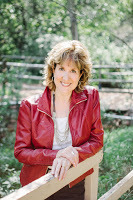 Beth K. Vogt believes God’s best often waits behind the doors marked “Never.” Having authored nine contemporary romance novels and novellas, The Best We’ve Been, the final book in Beth’s Thatcher Sisters Series with Tyndale House Publishers, releasers May 2020. Other books in the women’s fiction series include Things I Never Told You, which won the 2019 AWSA Award for Contemporary Novel of the Year, and Moments We Forget. Beth is a 2016 Christy Award winner, a 2016 ACFW Carol Award winner, and a 2015 RITA® finalist. An established magazine writer and former editor of the leadership magazine for MOPS International, Beth blogs for Learn How to Write a Novel and The Write Conversation and also enjoys speaking to writers group and mentoring other writers. Visit Beth at bethvogt.com.
Beth K. Vogt believes God’s best often waits behind the doors marked “Never.” Having authored nine contemporary romance novels and novellas, The Best We’ve Been, the final book in Beth’s Thatcher Sisters Series with Tyndale House Publishers, releasers May 2020. Other books in the women’s fiction series include Things I Never Told You, which won the 2019 AWSA Award for Contemporary Novel of the Year, and Moments We Forget. Beth is a 2016 Christy Award winner, a 2016 ACFW Carol Award winner, and a 2015 RITA® finalist. An established magazine writer and former editor of the leadership magazine for MOPS International, Beth blogs for Learn How to Write a Novel and The Write Conversation and also enjoys speaking to writers group and mentoring other writers. Visit Beth at bethvogt.com.



